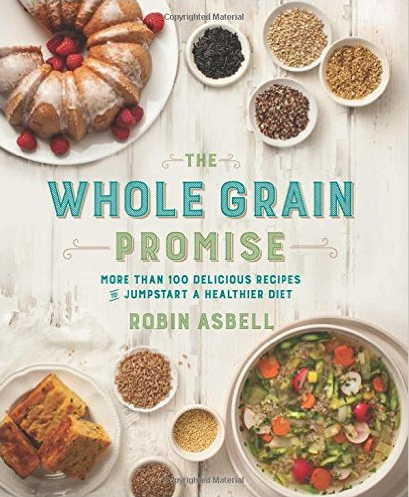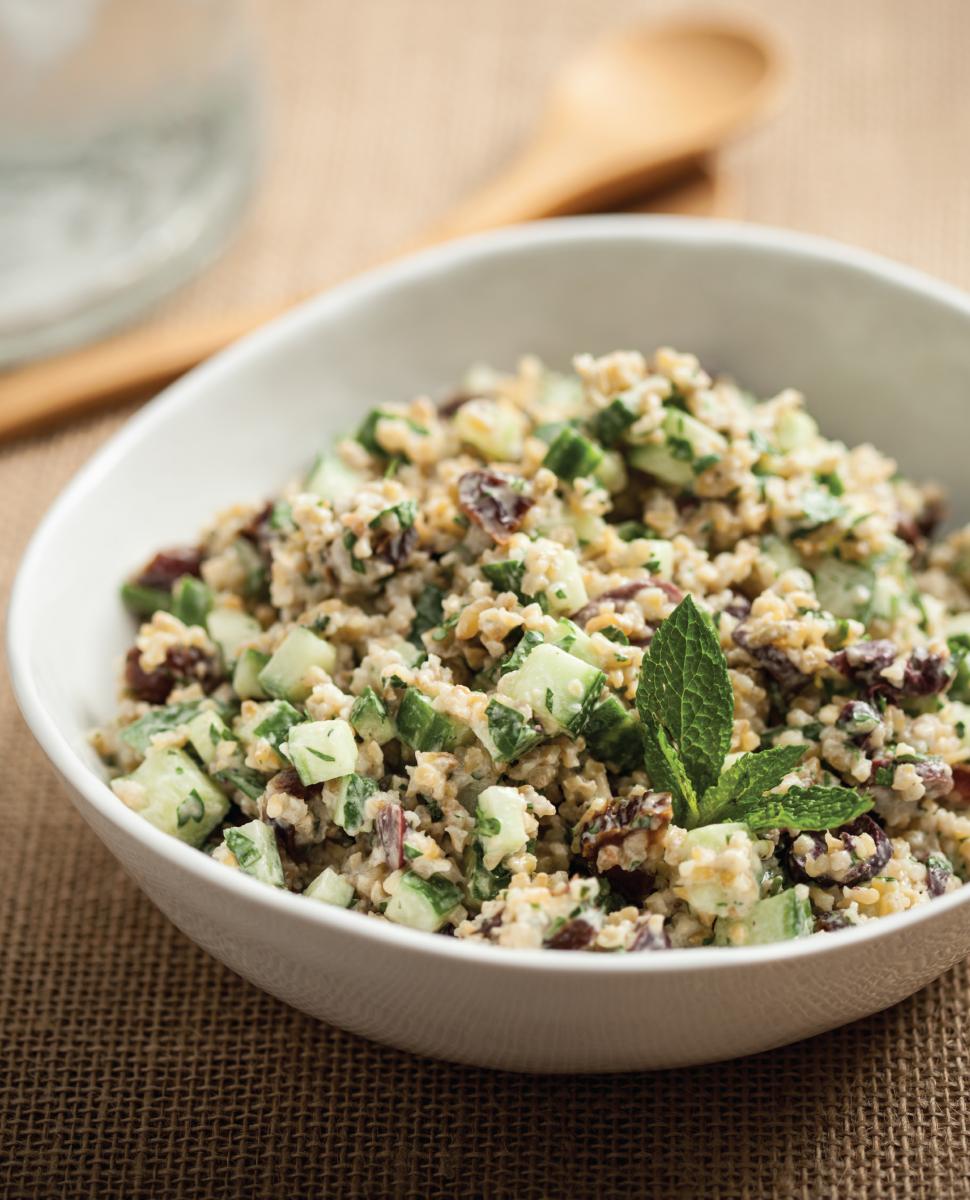Share This
We’ve long cherished our well-worn edition of The New Whole Grains Cookbook (2007), so we were delighted to finally get our hands on chef Robin Asbell’s latest tome, The Whole Grain Promise, which was released earlier this month. Last week, we had the opportunity to catch up with Asbell (one of the culinary advisors to the Oldways Whole Grains Council) and chat about her deliciously unfussy approach to whole grain cooking.
Even before her career as a chef, Asbell was no stranger to whole grains. “I actually really got into whole grains when I was a teenager,” Asbell recalls. “My mom taught me how to bake when I was a kid, and sometime in adolescence I became interested in healthy eating.” Asbell frequently turned to a whole wheat bread recipe in one of her mother’s cookbooks, and in no time, the young teen found her calling in the food world.
“One of my mom’s friends opened up a health food store in our town and I would bake four whole wheat loaves of bread for her in a week,” says Asbell, of her high school days. By the time she was cooking professionally, even the more obscure whole grains were staples in her repertoire. “I was working in a health food store in 1984 when we first got quinoa,” recalls Asbell. “It was fun to watch it grow [in popularity], because it was just another grain at the store.”
Asbell acknowledges that in many parts of the country, “You can’t just roll up to the grocery store and buy black rice.” For this reason, recipes in The Whole Grain Promise offer lots of simple substitution options and tips. “My thinking in developing all of the recipes was to make it very flexible and accessible,” says Asbell. “I didn’t do a lot in the book with things that are really hard to find.” Its fun to cook something exotic, but if you can’t find an ingredient, you can easily swap it out using Asbell’s guidance and suggestions.
In contrast to some of the more labor-intensive cookbooks written for passionate hobby cooks and food professionals, recipes in The Whole Grain Promise are designed with busy families in mind. Asbell has been “going out and talking about whole grains with the public for many years,” and “the primary thing that people will say is a barrier is time. Because brown rice takes forty minutes, they think all of them take an hour.” Asbell combats this fear by showcasing a variety of flavorful meals that can be put together quickly and easily, often in less time than it takes to bake a potato.
Like many health foods, whole grains sometimes face the misperception that nutrition implies an absence of flavor. In reality, the opposite is true. “People just assume that its going to be hard to get their kids to eat them or that their husband won’t like them,” but “that’s more of a mindset,” explains Asbell. Whole grains offer a variety of distinct flavors that add richness and depth to recipes, a complexity unattainable by bland refined grains.
Absbell has authored six previous cookbooks, including the aforementioned, The New Whole Grains Cookbook. But as the general public still appeared to be slow to adopt these delicious and nutritious foods, Asbell decided it was time to light the fire and write another whole grain cookbook, to address some of these challenges. The trend towards whole grains “was growing,” recalls the chef, of her motivation for tackling this project, “but not as fast as we would like.”
Inspired by related research from the University of Minnesota, in which consumers readily accepted products whose whole grain content gradually increased over time, The Whole Grain Promise also features recipes like “stealth bread” and “stealth pizza crust.” With this approach, Asbell explains, you begin with “some white flour, then less white flour, then no white flour in your bread. You could step up the amount of whole grain in your bread without your family even noticing.”
Asbell has ample experience getting families to be more open-minded about trying new whole grain foods. “I have worked as a private chef for about 20 years and I’ve introduced a lot of families to healthy eating,” she explains. Her words of wisdom? “Don’t talk about it.” In other words, it’s better not to plant the idea that recipes are healthy, but to focus instead on their rich flavors and tantalizing tastes and textures.
As Asbell writes in her new book, The Whole Grain Promise is a celebration of whole grains “for their glorious, sensual wonders.” Are you ready to join the party? Asbell is kindly sharing the recipe for her Middle Eastern Freekeh Salad with Sesame-Yogurt Dressing, below. For more inspired recipes, be sure to pick up a copy of this mouthwatering new book.
And now for the Giveaway: Name your favorite whole grain food in the comments below, and we’ll randomly select 5 winners one week from today to receive their very own copy of the book!
Reprinted with permission from The Whole Grain Promise © 2015 by Robin Asbell, Running Press, a member of the Perseus Books Group.
Middle Eastern Freekeh Salad with Sesame-Yogurt Dressing
Green wheat freekeh is the grain to watch, now that people have discovered its nutty, slightly toasted flavor. Because the wheat is harvested “green” and then roasted before hulling, chopping, and drying, freekeh has a deep flavor that you will love. Try it in this salad, with creamy yogurt dressing and little surprises like dates and olives in every bite.
Serves 4 to 6 (makes 6 cups)
Ingredients
1 cup freekeh, bulgur, or brown rice
1 cup fresh parsley leaves
½ cup fresh mint leaves
2 tablespoons honey
2 tablespoons tahini
½ cup plain Greek yogurt
2 tablespoons freshly squeezed lemon juice
2 tablespoons extra-virgin olive oil
1 teaspoon salt
1 medium cucumber, peeled, seeded, and chopped
½ cup pitted dates, sliced
½ cup Kalamata olives, sliced
Instructions
1. Cook the grain according to package instructions (or use the cooking instructions in this chart). Bring the required amount of water to a boil and add the grain. Return to a boil, cover tightly, then reduce the heat to the lowest setting. Cook, covered, for the suggested time. When all the water is absorbed, take the grain off the heat and let stand, covered, to steam for 5 minutes. Uncover and fluff to cool. Let cool completely. Can be made ahead and chilled.
2. Put the parsley and mint in the bowl of a food processor and mince, or mince the herbs by hand and place in a bowl. Add the honey, tahini, yogurt, lemon juice, olive oil, and salt and process or stir to mix.
3. Transfer the cooled grain to a large bowl and pour in the dressing, then add the cucumber, dates, and olives. Toss to mix, and serve.
4. Keeps for 3 days, tightly covered, in the refrigerator.



Comments
Hi Michelle - You've been selected as a winner! Please email kelly@oldwayspt.org for more details.
Hi Jessica - You've been selected as a winner! Please email kelly@oldwayspt.org for more details.
Hi Stefanie - You've been selected as a winner! Please email kelly@oldwayspt.org for more details.
Hi Mary - You've been selected as a winner! Please email kelly@oldwayspt.org for more details.
Hi Christine - You've been selected as a winner! Please email kelly@oldwayspt.org for more details.
Add a Comment